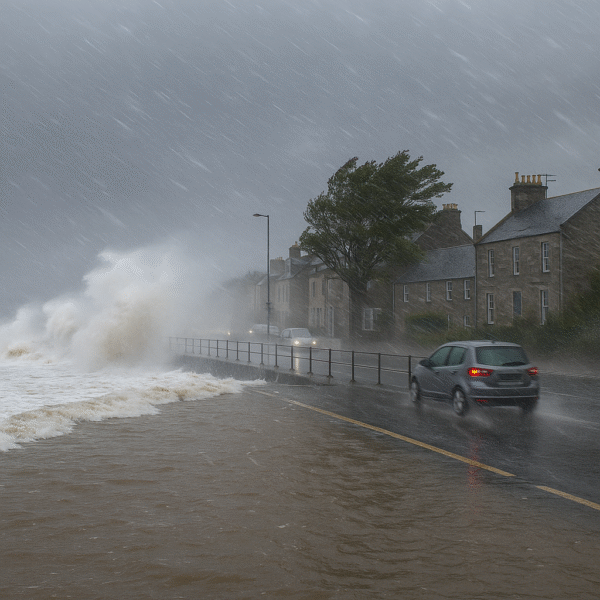The United Kingdom is facing unprecedented disruption as Storm Amy sweeps across the country, unleashing 90mph winds, torrential rainfall, and severe flooding. The powerful storm, one of the most destructive in recent years, has left more than 100,000 people dealing with widespread travel chaos, power outages, and significant infrastructure damage. From England to Scotland, communities are battling the storm’s unrelenting fury, with authorities warning that the impacts will linger well beyond the weekend.
Widespread Chaos Across the UK
As the storm made landfall, residents and travelers were confronted with scenes of flooded roads, collapsed buildings, and grounded transport systems. Flights, rail services, and ferry routes were canceled, stranding thousands of passengers. On the roads, standing water and fallen debris made driving treacherous, forcing emergency closures in several regions.
Local councils and emergency services have been stretched to their limits, responding to calls for assistance and attempting to restore essential services. Despite these efforts, the relentless winds and rainfall have complicated recovery, delaying progress in restoring power and reopening transport routes.
Met Office Warnings and Escalating Alerts
The Met Office initially issued a yellow weather warning for wind, covering the entire country. However, as the storm strengthened, an amber warning was raised for northern Scotland, where gusts exceeding 90mph were recorded. These warnings highlighted the risks of falling trees, damaged buildings, and further flooding, urging residents to avoid non-essential travel and remain indoors where possible.
The warnings have been echoed by the Scottish Government and local authorities, who are prioritizing public safety. They have urged citizens to stay updated with weather alerts and follow guidance on travel restrictions, particularly on major roads and bridges.
Severe Impact on Transport and Infrastructure
Storm Amy’s ferocity has brought the UK’s transport network to a standstill. Scotland has been particularly hard-hit, where iconic bridges such as the Forth Road Bridge and the Tay Road Bridge were forced to close due to dangerous wind speeds. The closures caused long delays for commuters and travelers, while restrictions on high-sided vehicles remained in place on several other crossings, including the Queensferry Crossing and Skye Bridge.
Rail services across the country faced mass cancellations, with operators citing fallen trees on tracks and flooding of rail lines. Airports in northern and western regions experienced widespread flight delays, forcing many passengers to rebook or abandon travel plans altogether. Ferry services connecting coastal communities were also suspended, cutting off access to some islands until conditions improve.
Power Cuts and Collapsed Buildings Add to Crisis
Tens of thousands of homes across the UK have been left without power as the storm damaged power lines and substations. Restoration efforts are underway, but engineers face ongoing challenges in reaching affected areas due to dangerous conditions. Some households are expected to remain without electricity for several days, raising concerns about heating, especially as colder autumn nights set in.
In Glasgow, tragedy was narrowly avoided when a building collapsed under the strain of heavy winds, crushing a parked car and forcing emergency road closures in the city center. Thankfully, no fatalities were reported, but the incident underscored the destructive potential of the storm.
Emergency Services on High Alert
Across the UK, emergency services have been working tirelessly to respond to the crisis. Firefighters, paramedics, and local authorities have dealt with hundreds of incidents ranging from fallen trees blocking roads to homes being flooded. Rescue teams have been deployed in severely affected areas to assist residents trapped by rising floodwaters.
Government officials have urged patience as recovery continues, emphasizing the scale of the challenge. With thousands of households displaced and critical infrastructure damaged, full recovery is expected to take weeks.
Tourism and Travel Sector Hit Hard
The storm’s timing has dealt a blow to the UK’s tourism industry, which relies heavily on weekend travel and seasonal visits to cultural attractions. Popular tourist destinations in Scotland, the Lake District, and coastal areas have been forced to close due to hazardous conditions. Hotels and hospitality businesses are reporting cancellations as travelers abandon plans to visit affected regions.
The storm has highlighted the vulnerability of the tourism sector to extreme weather, with local economies now facing additional strain during what should be a busy autumn season.
Looking Ahead: Recovery and Climate Concerns
Meteorologists are closely tracking Storm Amy’s progress, warning that further rainfall and strong winds are likely in the coming days. The storm has reignited concerns about the increasing frequency and severity of extreme weather events in the UK, with experts pointing to climate change as a major contributing factor.
Communities already recovering from previous storms are once again grappling with damaged infrastructure, raising questions about the nation’s resilience to severe weather. Discussions around long-term adaptation strategies, including flood defenses and investment in infrastructure, are expected to intensify in the aftermath.
Conclusion
Storm Amy has left an indelible mark on the United Kingdom, disrupting lives, damaging infrastructure, and highlighting the growing challenges posed by climate change. As emergency services continue recovery operations, the focus remains on protecting lives and restoring normality. However, the storm serves as a stark reminder that the UK must strengthen its resilience to withstand the rising threat of extreme weather.
For now, residents across the nation are urged to remain cautious, follow official advice, and prepare for ongoing disruptions. While the storm’s immediate impact may ease in the coming days, its consequences will be felt for weeks to come.
For more travel news like this, keep reading Global Travel Wire
















